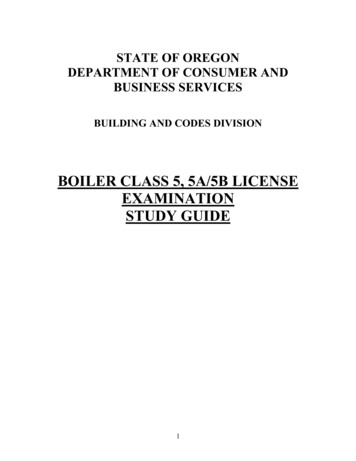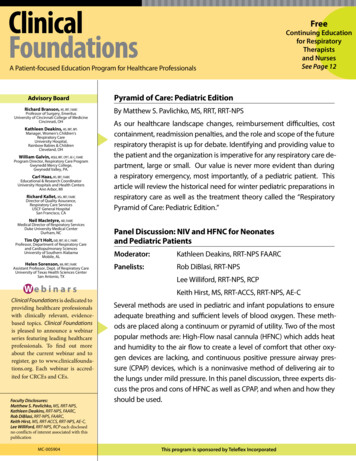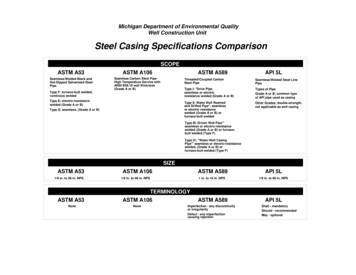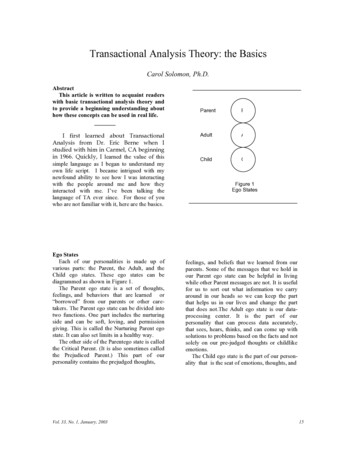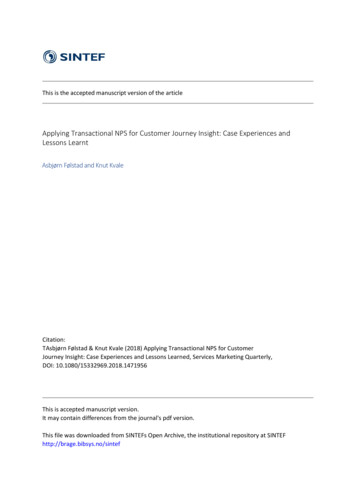
Transcription
This is the accepted manuscript version of the articleApplying Transactional NPS for Customer Journey Insight: Case Experiences andLessons LearntAsbjørn Følstad and Knut KvaleCitation:TAsbjørn Følstad & Knut Kvale (2018) Applying Transactional NPS for CustomerJourney Insight: Case Experiences and Lessons Learned, Services Marketing Quarterly,DOI: 10.1080/15332969.2018.1471956This is accepted manuscript version.It may contain differences from the journal's pdf version.This file was downloaded from SINTEFs Open Archive, the institutional repository at SINTEFhttp://brage.bibsys.no/sintef
Running head: TRANSACTIONAL NPS FOR CUSTOMER JOURNEY INSIGHT1Applying Transactional NPS for Customer Journey Insight:Case Experiences and Lessons LearntAsbjørn Følstad and Knut KvaleSINTEF and TelenorAuthor NoteAsbjørn Følstad, SINTEFKnut Kvale, Telenor ResearchThe presented work was supported in part by the Norwegian Research Council, grantsno. 919800 (Customer Care 2015) and 203432 (Center for Service Innovation).Correspondence regarding this article should be addressed to Asbjørn Følstad, SINTEF,Forskningsveien 1, 0373 Oslo, Norway. Contact: asf@sintef.no
TRANSACTIONAL NPS FOR CUSTOMER JOURNEY INSIGHT2AbstractWhile the concept customer journeys is widely taken up to support service design andmanagement, practical frameworks for routine monitoring of customer experience in thecontext of customer journeys are lacking. This paper proposes a framework for applying thewidely used transactional Net Promoter Score (NPS) as a means for gathering insight intocustomers' experiences of a customer journey. We present lessons learnt from three case trialsof the framework elements within a telecom service provider, involving the analysis of morethan 1700 quantitative and qualitative customer responses from transactional NPS surveys.Keywords: transactional Net Promoter Score (NPS), customer journey, customerexperience monitoring, service management
TRANSACTIONAL NPS FOR CUSTOMER JOURNEY INSIGHT3Applying Transactional NPS for Customer Journey Insight:Case Experiences and Lessons LearntLeading service companies strive to improve the experience of their key customerjourneys (Edelman & Singer, 2015), as strengthened performance on customer journeys hasbeen found to correspond to increases in customer satisfaction and company growth (Rawson,Duncan, & Jones, 2013). For this purpose, companies need to gather insight into customers'evolving experience of these journeys, so as to enable the careful shaping, orchestration, andmaintenance of the elements of the journey (Halvorsrud, Kvale, & Følstad, 2016). Inparticular, companies need to build capacity for the routine monitoring and assessment ofcustomer experience in the context of customer journeys.However, such routine monitoring and assessment of customer experience ischallenging. This challenge is in part due to the subjective character of customer experience(Palmer, 2010) and its wide range of drivers (Verhoef et al., 2009). Furthermore, the contextof customer journeys entails the evolving of customer experience throughout the servicedelivery process (Lemon & Verhoef, 2016). The literature is surprisingly silent on how toaddress this challenge. Whereas previous research has reported on the in-depth customerjourney mapping which typically precedes larger service design projects (Meroni &Sangiorgi, 2011; Stickdorn & Schneider, 2010), researchers have offered little support for theroutine monitoring and assessment of customer experiences for a service provider's keycustomer journeys. This gap in the literature is critical, as the lack of such support leavesservice designers and managers without continuous updates on the customer experience forimplemented service processes.One means to assess customers' experience, widely taken up by the service industry inrecent years, is the Net Promoter Score (NPS) (Reichheld, 2003). NPS is set out as a measureof likelihood to recommend. That is, it concerns customers' behavioural intentions rather than
TRANSACTIONAL NPS FOR CUSTOMER JOURNEY INSIGHT4experience (Keiningham, Cooil, Andreassen, & Aksoy, 2007). Nevertheless, NPS has beenextensively taken up as a means to gather insight into customer experience (Temkin, 2014). Inparticular, the combination of quantitative and qualitative feedback, provided through what isoften referred to as transactional NPS (Qwen & Brooks, 2009), may be useful for gaininginsight into customer experience. Here, customers provide feedback on their likelihood torecommend the service provider after a specific service interaction, and their reasons forrecommending or not (Reichheld, 2003). These reasons, provided by customers in their ownwords, constitute a rich source of insight into the customer experience associated with specifictouchpoints along the customer journey, or for the customer journey at large.In this paper, we provide a framework for service designers and managers to leveragetransactional NPS for monitoring and assessment of customer experience in the context ofcustomer journeys. We detail the characteristics of transactional NPS that make it suitable forthe purpose, in particular its characteristic as a quant-qual instrument (combining quantitativeand qualitative data collection) as well as its under-determined character (where the customermay interpret the question with regard to what is seen as particularly important to thecustomer in the specific service context). Furthermore, we suggest two types of approaches todata collection and analysis: assessment-based approaches, which take as a point of departurethe customers' assessment of a service process, and deviation-based approaches, which take astarting point in deviations from the service process as planned by the service provider.The study contributes to two bodies of knowledge: the literature on customer journeysand the literature on NPS. To our knowledge, the study is unique in that it bridges these twobodies of knowledge, thereby providing a basis for researchers and practitioners that seek tobenefit from merging these widespread industrial practices.
TRANSACTIONAL NPS FOR CUSTOMER JOURNEY INSIGHT5BackgroundAnalysing the Customer JourneyThe perspective of customer journeys concerns the service process as seen from theviewpoint of the customer. Here, customers are followed through a service process with theaim of gathering insight into their experience of this process. The customer journey is seen asconsisting of a series of steps or stages (Lemon & Verhoef, 2016), or as a sequence oftouchpoints (Halvorsrud et al., 2016) in which the customer interacts with the service providertowards reaching a particular service goal. The customer journey is typically represented inthe form of a customer journey map, that is, a structured presentation of the elements of thecustomer journey and their relations established based on customer research or companyinternal expertise (Halvorsrud et al., 2016).Investigating customer experience in the context of customer journeys is challenging.The relevant journeys may involve a large number of touchpoints and be characterized by cocreative relations between customers and providers (Zomerdijk & Voss, 2010). The customerexperience may change significantly and unexpectedly throughout the customer journey(Rawson et al., 2013; Lemon & Verhoef, 2016), and relevant aspects of the customerexperience may concern both the service process and its outcome. Often, there is a gapbetween how the service process is planned or expected by the service provider and how theservice process is actually experienced by the customers (Halvorsrud et al., 2016).A number of approaches have been proposed to analyse customer experience in thecontext of customer journeys (Følstad & Kvale, 2018). Those most frequently reportedinvolve the use of qualitative methods such as field-studies, observation, and interviews forin-depth investigations (Meroni & Sangiorgi, 2011; Stickdorn & Schneider, 2010). Thesemethods indeed provide rich insight, and are typically applied as part of larger service design
TRANSACTIONAL NPS FOR CUSTOMER JOURNEY INSIGHT6or innovation projects. However, they arguably are too resource demanding for routinemonitoring of customer experience in established service processes.Also, quantitative approaches have been proposed to investigate customer's behaviouror experience throughout the customer journey. Among these is the analysis of log data toinvestigate customers' behavioural patterns during online customer journeys (Anderl, Becker,von Wangenheim, & Schumann, 2016; Lee, 2010). However, such log analysis does notprovide direct insight into the subjective customer experience, and may leave out interactionsexperienced by the customer but not captured in the available log data. Others have proposedusing self-reported metrics, as an alternative quantitative approach. For instance, Rawson etal. (2013) applied a self-report satisfaction metric across the customer journey. Self-reportmetrics of customer experience are indeed valuable, as they potentially provide reliable andgeneral high-level knowledge about how customer experience varies throughout a customerjourney. However, they may not enable needed insight into the underlying drivers of customerexperience, as these are likely to be contextually dependent (Palmer, 2010).In Table 1, we summarize the current approaches for investigating customer experiencein the context of customer journeys.Table 1Current Approaches for Studying Customer Experience in Customer JourneysApproachLimitationsExample referencesQualitative: In-depth fieldstudies, observation, diaries,and/or interviews.Time and resource demandsprohibitive for routineapplication.Trischler & Zehrer, 2012Halvorsrud et.al., 2016Quantitative: Analyses ofonline behaviour based onserver log data.Cover only customerinteractions from log data. Onlybehaviour, not experience.Anderl et al., 2016Lee, 2010Quantitative: Self-reportexperience metricsLimited insight into the driversof customer experience.Rawson et al., 2013Wozniak et al., 2017
TRANSACTIONAL NPS FOR CUSTOMER JOURNEY INSIGHT7While both the in-depth qualitative approaches and the high-level quantitativeapproaches are duly represented in the literature, it is noteworthy that approaches to leveragegathering of qualitative experience feedback from larger respondent groups are absent. It is inthis context that we see the potential of transactional NPS to fill the gap as a means to monitorcustomer experience throughout the customer journey. To our knowledge, no previous workhas described how transactional NPS may be applied for this purpose.Transactional NPS as a Source of Insight into Customer ExperienceNPS has been established as a much-used approach for gathering customer feedback acrossservice industries (Temkin, 2014). NPS is applied for two distinct purposes: on the one hand tomonitor customers' overall perceptions of the brand and their relation with the company (“topdown NPS”), and on the other hand to monitor customers' assessments of particular transactionswith the company (“transactional or bottom-up NPS”) (Reichheld & Markey, 2011).Transactional NPS is used to monitor and improve specific offerings or servicefunctions within a company. Data for transactional NPS is often gathered immediatelyfollowing a service interaction; for example, after interacting with a call centre, completing apurchase in store, or visiting a company's customer website. Here, customers report on theirinclination to recommend the company based on the specific interaction, through a singleitem likelihood-to-recommend (LTR) question. The LTR question may be phrased in differentways, but typically follows this pattern: "How likely is it that you would recommend us (orthis product/service/brand) to a friend or colleague?" (Reichheld & Markey, 2011). Hence, theLTR question may be open to interpretation by the customers, as it only to a limited degreesuggests which factors they should consider as basis for their recommendations of theproduct, service, or brand to others.To apply NPS for intra-organizational learning, Reichheld (2003) advise supplementingthe LTR question with a free-text reason-for-score question. Here, customers report in their
TRANSACTIONAL NPS FOR CUSTOMER JOURNEY INSIGHT8own words the main reason for their assessment. While the LTR question may be open tointerpretation in terms of the underlying drivers of recommender behaviour, the reason-forscore question provides insight into these same drivers. Thus, the customers' reports onreasons-for-score provide insights into both what customers like in the service transaction andproblems or sources of discomfort that they may have experienced, and is hence a veritablesource of customer experience feedback. On this basis, it is understandable that Temkin(2014) considers transactional NPS a prominent customer experience metrics.In spite of its widespread uptake, only a few studies on transactional NPS have beenreported in the academic literature (e.g. Feehan, Ilangakoon, & Mesure, 2009; Whitlark &Rhoads, 2011). To our knowledge, no studies have provided in-depth reports on the gatheringand analysis of qualitative data through the reason-for-score question, though some papers onorganizational improvement through the use of NPS report in general terms on the benefit ofsuch qualitative data (Markey, Reichheld, & Dullweber, 2009; Reichheld, 2006).Research Objective and Requirements for the FrameworkThe research objective of this work is to propose a framework for applying transactionalNPS to monitor and assess on regular basis the customer experiences in the context of thecustomer journey. To meet this research objective, the transactional NPS and the frameworkwithin which it is applied should satisfy the following requirements (R1-R4): R1: Support comparing service performance to benchmarks and business goals; R2: Provide insight into key customer experiences and experiential drivers; R3: Provide actionable insight into customer problems or pain-points as well asopportunities for service improvement; and R4: Be sufficiently general so as to be applicable across customer journeys.These four requirements will be referred to below, both when presenting the frameworkand in the discussion of the framework based on the case experiences.
TRANSACTIONAL NPS FOR CUSTOMER JOURNEY INSIGHT9FrameworkThe Basis: The Customer Journey Map and the Transactional NPSTo monitor customer experiences for a particular customer journey, the starting point isa customer journey map representing the elements of the customer journey and their relations(see e.g. Halvorsrud et al., 2016; Stickdorn & Schneider, 2010). Through such mapping, theservice journey has been delimited through well-defined start- and end-points, and keytouchpoints have been identified.To this customer journey map, specific points can be assigned for assessment throughtransactional NPS. We specifically consider transactional NPS applied as an end-pointmeasure, when the customer has reached the goal of the journey, as a start-point measure,when the customer is about to begin the journey, or as a touchpoint measure, when thecustomer interacts with the company in between the journey's beginning or end.The transactional NPS holds the characteristic of what we refer to as a quant-qualinstrument. That is, it includes a quantitative component that serves as a metric forbenchmarking within and across customer journeys, and a qualitative component that servesto explain the score provided through the metric, thereby providing insight into the underlyingcustomer experience.With its single-item LTR component, the transactional NPS match well the requirementto support benchmarking and comparisons between competitors, among company units, andacross time (R1). Furthermore, this single-item component is sufficiently general so as to beapplicable throughout and across journeys (R4). With its qualitative reason-for-scorecomponent, the transactional NPS support the gathering of qualitative data where customersreport on their experiences in their own words (R2).The phrasing of the LTR question does not strongly guide the customer towards whichaspects of the service experience that should be considered, something we assume to
TRANSACTIONAL NPS FOR CUSTOMER JOURNEY INSIGHT10strengthen its versatility as a quant-qual measurement instrument. Rather, the LTR questionarguably has what we refer to as an under-determined character; that is, the range of possibledrivers that could motivate customer recommendations is broad and the respondents havemuch freedom in deciding what should motivate their answers.Two Approaches for Applying Transactional NPS in the Context of Customer JourneysWhen applying transactional NPS for the investigation and monitoring of customerexperience, it must provide insight into the key drivers and aspects of the customer journeyexperience (R2). At the same time, following Dixon et al. (2010), threats to customerexperience reside not only in service providers' failure to facilitate great service experiences,but also their failure to have the customer journey proceed as planned or expected (R3). Tocover these two needs, we propose two approaches for applying transactional NPS as a quantqual instrument: An assessment-based approach, addressing the gathering of customerexperience data related to key drivers and aspects of the customer experience, and a deviationbased approach, concerning the gathering of customer experience data specifically related toproblems or pain-points during the customer journey.The assessment-based approach. The aim of the assessment-based approach is togather insight into key experiences and experiential drivers pertaining to the customer journeyas it is designed, planned, or expected by the service provider. In its simplest form, theassessment-based approach may be instantiated as an end-point measure, providing insightinto key experiences and experiential drivers as they are remembered by the customer at theend of the customer journey (i.e. when the customer’s goal for the journey is achieved).Though simple to administer, the end-point measure does not give insight into how thecustomer experience evolved across the customer journey. To provide such insight, theassessment-based approach may be extended with a start-point measure, for a start-end
TRANSACTIONAL NPS FOR CUSTOMER JOURNEY INSIGHT11analysis. The start-end analysis will be relatively easy to implement, as the start-point andend-point of the customer journey typically occur at points known to the service provider.For longer journeys, it may be valuable to extend the assessment-based analysis withcustomer feedback on one or more of the touchpoints between the extremities of the of thecustomer journey. These touchpoint measures will provide additional insight into keycustomer experiences and experiential drivers—both the role a particular touchpoint may havein shaping the experience of the subsequent touchpoints and the whole customer journey andthe role the journey may have in shaping the experience of the particular touchpoint.The deviation-based approach. The customer journey as planned or expected by theservice provider is often disrupted by problems or mishaps on the side of the customer.However, in spite of being potentially detrimental to the customer experience, such problemsor pain-points may go unnoticed by the service provider and ultimately lead to customerdeflection (Meyer & Schwager, 2007).To monitor and assess problems or pain-points faced by a customer during the customerjourney, the transactional NPS may be applied in a deviation-based approach. Here, thecustomer is specifically asked for experiences of problems or mishaps, or for problemindicating behaviour such as several calls to customer service, during the journey.The deviation-based approach is intended as a complement to the assessment-basedapproach. From the perspective of the service provider, insights on deviations in the customerjourney complement insights from general customer assessments. From the customer'sperspective, requests for retrospective feedback on deviations during the service process maybe an acceptable addition to requests for feedback on the service process at large.
TRANSACTIONAL NPS FOR CUSTOMER JOURNEY INSIGHT12Case ExperiencesThis section presents three case studies in which the proposed framework has beenapplied. The cases were conducted in the context of a particular service provider; one of theoperations of a major international telecom company.The first case demonstrates the under-determined character of the quantitative LTRquestion, and the benefit of such under-determination. Case 2 shows the assessment-basedapproach, and Case 3 exemplifies the deviation-based approach.Case 1: NPS as an Under-determined QuestionCase 1 demonstrates how the under-determined character of the LTR question supportscustomer insight on a wide range of experiential drivers. In particular, the case shows how thequestion elicits customer responses not only addressing the object of assessment (referred toas target), but also other aspects of the service process or the company (referred to asspillover).Background. Prior to this study, the case company had implemented transactional NPSacross all operations. The company used transactional NPS to gather customers' assessment ofparticular touchpoints, such as Customer Service and stores. For example, after having calledCustomer Service, customers were asked to respond to the following question: "On the basisof your experience concerning your recent call to Customer Service, how likely are you torecommend [the company] to your family, friends, and colleagues?" on a scale from 0 (not atall likely) to 10 (extremely likely). Customers responding to the LTR question were alsoasked to respond in free text on the reason-for-score question: "What was the primary reasonfor your score?".The company regarded transactional NPS as providing useful input for serviceimprovement. However, the company had also noted that many of the customers tended toreport other reasons for their LTR score than those pertaining to the touchpoint of interest. On
TRANSACTIONAL NPS FOR CUSTOMER JOURNEY INSIGHT13this background, this study analysed 1100 reason-for-score reports provided after thecustomers' calls to Customer Service.Method. The customer reports were selected through stratified sampling where 100reports for each of the 11 possible LTR scores (0 through 10) were randomly chosen from thetotal set of 200000 such reports for a given 13-month period (October 2013 – October 2014).The reports were analysed in a thematic analysis (Ezzy, 2013), conducted by the first authorand subsequently checked by the second, to identify and code the types of reason-for-score,and in a content analysis (Ezzy, 2013) to determine the object (target or spillover) of theresponse. In the latter analysis, a response was coded as target if it concerned the particularCustomer Service interaction and spillover if it concerned backstage customer serviceprocesses, general products and services, or brand perception. Example target reasons-forscore included service agent attitude, service agent knowledge, whether help or solution wasprovided, and waiting time and ease of access. Example spillover reasons-for-score includedbrand perceptions, product experiences, and experiences with the service process at large.Responses addressing aspects of the particular Customer Service interaction as well as otheraspects of the service process or provider were coded as both target and spillover.Findings. The analysis gave several interesting findings. First, a substantial proportionof the reason-for-score reports were coded as spillover; 23% were coded spillover only, 15%were coded both target and spillover. Second, the spillover reports typically were associatedwith lower LTR scores. For the lowest-scoring customers (LTR scores 0 to 6; detractors inNPS jargon), 31% were coded spillover only and 15% were coded both target and spillover.This finding contrasts the highest scoring customers (LTR 9 or 10; promoters in NPS jargon)for whom just 9% of the reports were coded as spillover only and 18% were coded as bothtarget and spillover. The middle scoring customers (LTR 7 or 8; passives in NPS jargon) had
TRANSACTIONAL NPS FOR CUSTOMER JOURNEY INSIGHT14somewhat more spillover comments than the highest scorers did, but fewer than the lowestscorers (10% coded as spillover only and 28% coded as both target and spillover).This finding has critical implications for service design and management. For managersof Customer Support, it is important to recognize the substantial proportion of low LTRscores that originates from issues depending on other departments in the company. Reportingsuch issues in a standardised manner to the respective responsible managers will enable themto take actions on the insights. For designers and managers aiming to improve customerexperience, it is important to recognize the combined effect of multiple touchpoints informing the customer experience.Case 1 clearly demonstrates that the LTR question has an under-determined character.For the lowest-scoring customers in particular, the frequency of spillover was substantial.Furthermore, Case 1 illustrates the benefit of such under-determination, provided the questionis an integrated part of a quant-qual instrument; the LTR question supports a high-levelquantitative assessment of customer experience while the free-text reason-for-score questionsupports the development of a case-specific model or understanding of the key drivers ofcustomer experience with implications not only for the touchpoint in question but for thewider customer journey.Case 2: Experiences with the Assessment-based ApproachCase 2 shows the application of the assessment-based approach where NPS is used in astart-end analysis to investigate customer experience in the context of a customer journey.Background. Case 2 concerns the customer journey of service recovery (Spreng et al.,1995). The complexity of telecom services implies frequent needs for service recovery.Hence, this customer journey, which we refer to as a service recovery journey, is key to thecase company. As an illustration of its importance, the Customer Service in the case companyat the time of the study handled around 300 million calls yearly across all operations. The
TRANSACTIONAL NPS FOR CUSTOMER JOURNEY INSIGHT15service recovery journey typically starts when the customer experiences a problem in theservice delivery and ends when the customer acknowledges the problem as fixed. The journeycan involve touchpoints such as a call to Customer Service for problem registration, messagesfrom the service provider on the status of the service recovery progress, a visit by repairpersonnel (optional), and a message from the service provider when the problem is fixed.Method. To understand how the customer experience was formed during the servicerecovery journey, this study conducted a start-end analysis based on transactional NPSresponses. The start-point measure was the transactional NPS responses immediately after thecustomers' initial call to Customer Service for problem registration. Here, the LTR and thereason-for-score questions were formulated as in Case 1. The end-point measure was a NPSdata collection following the entire service recovery process. Here, the LTR question wasphrased: "On the basis of your experience concerning the recent fault handling process, howlikely are you to recommend [the company] to your family, friends, and colleagues?". As inCase 1, the LTR answers alternatives ranged from 0 (not at all likely) to 10 (extremely likely)and respondents were followed up with the reason-for-score question.Responses were gathered across a six-month period (September 2014 – February 2015).In total, 2341 customers responded to the LTR question at the journey start-point and endpoint. Of these, 319 provided free-text reason-for-score reports on both occasions. Thequantitative data were made subject to a descriptive analysis. The free text reports wereanalysed in a thematic analysis (Ezzy, 2013), conducted by the two authors collaboratively, toidentify and code the types of reason-for-score. To analyse change across the customerjourney, the customer reports at the start-point and end-point were analysed and coded as oneunit. The coded reports were then grouped according to the corresponding start- and end-pointscores for the LTR question. The resulting groups were All High (LTR score 7 for both startand end-point), All Low (LTR score 6 for both start- and end-point), Falling (LTR score 7
TRANSACTIONAL NPS FOR CUSTOMER JOURNEY INSIGHT16for start-point, LTR score 6 for end-point), and Rising (LTR score 6 for start-point, LTRscore 7 for end-point). The cut-off at score 6 corresponds to the NPS category detractors(Reichheld, 2003).Findings: The customers' reason-for-score reports provided insight into a wide range ofkey experiences, some reflecting experiential breaks or changes across the service recoveryprocess, others reflecting stability or predictability. In the group All High (64% of theresponses) the customers reported on positive experiences throughout the journey, typicallydue to a pleasant meeting with Customer Service personnel at the start of the process andsatisfaction with the process outcome, the status reports during the service recovery process,and the process duration. In All Low (16% of the responses) nearly all reported processproblems, such as service recovery taking too long and having to make multiple inquiries. Asubstantial proportion reported on problems that had lasted for longer than just this servicerecovery process, and some reported that they still experienced the problem even after servicerecovery. In Fa
towards reaching a particular service goal. The customer journey is typically represented in the form of a customer journey map, that is, a structured presentation of the elements of the customer journey and their relations established based on customer research or company internal expertise (Halvorsrud et al., 2016).

